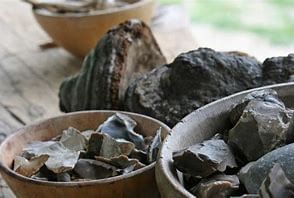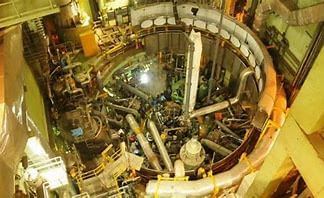UPSC Daily Current Affairs- 5th March 2024 | Current Affairs & Hindu Analysis: Daily, Weekly & Monthly PDF Download
GS-I
Copper Age
Subject: History & Culture

Why in News?
Archaeologists in Italy recently made a remarkable discovery of a 5,000-year-old cemetery that belonged to a Copper Age society.
About
- Copper Age Overview:
- The Copper Age, also known as the Chalcolithic period, lasted roughly from 5,000 to 2,000 years ago, varying by region.
- It marked a transition from the Neolithic era to the Bronze Age.
- Key Features:
- Notable for the introduction of metallurgy, particularly the use of copper alongside stone tools.
- Witnessed the rise of craft specialization, agriculture, long-distance trade, and increased sociopolitical complexity.
- Farmers predominantly raised livestock such as sheep-goats, cattle, and pigs, supplemented by hunting and fishing.
- Cultivation included barley, wheat, and pulses.
- Polychrome painted pottery was a distinctive feature.
- Housing comprised stone or mudbrick structures, often organized in chain buildings or around central courtyards.
- Societal Dynamics:
- Early evidence of massacres, battles, and warrior burials emerged during this period.
- Transition to Bronze Age:
- By the end of the Copper Age, the discovery that adding tin to copper produced stronger metal led to the Bronze Age's inception.
Source: The Times of India
Venice Biennale: The Olympics of the Art World
Subject: Art and Culture

Why in News?
The Venice Biennale, revered as “the Olympics of the art world,” is set to unveil its 60th edition on April 20.
- Under the theme “Stranieri Ovunque” or “Foreigners Everywhere,” curated by Adriano Pedrosa, the exhibition will feature 333 artists from around the world.
What is the Venice Biennale?
- Inception: Proposed by Venice’s city government in 1893, the Biennale aimed to commemorate the silver jubilee of King Umberto I and Queen Margherita of Italy.
- Early Exhibitions: The inaugural exhibition in 1895 attracted over two lakh visitors, showcasing works by foreign and Italian artists without specific thematic constraints.
- Central Pavilion: Serving as the focal point, the central pavilion hosts the main exhibition curated by the appointed curator, highlighting selected artworks.
- National Pavilions: Representing individual countries, these pavilions feature curated exhibitions managed by respective ministries of culture, with India having participated officially since 1954.
- Collateral Events: Independent exhibitions and events across Venice complement the Biennale, enriching the cultural landscape.
- Debut in 1954: India made its inaugural appearance with an exhibition organized by the Embassy of India in Rome, featuring eminent artists like M F Husain and Amrita Sher-Gil.
- Subsequent Engagements: Indian artists have participated in various editions, with official pavilions organized in 2011 and 2019, showcasing diverse artistic expressions.
- Continued Representation: In 2024, Indian artists will feature prominently in the central exhibition, alongside the Aravani Art Project, symbolizing India’s enduring presence on the global art stage.
Source: Indian Express
GS-III
HPV Vaccination
Subject: Science and Technology

Why in News?
Every year, March 4 is observed as International HPV Awareness Day.
What is Human Papillomavirus (HPV)?
- HPV Overview:
- HPV comprises over 200 related viruses, with more than 40 being transmitted through sexual contact.
- Two HPV types lead to genital warts, while around twelve types can cause various cancers, with over 95% of cervical cancer cases attributed to HPV.
- Transmission:
- HPV is the most prevalent sexually transmitted infection globally and spreads through direct sexual contact.
- It can also transmit via skin-to-skin contact, with most infected individuals showing no symptoms, remaining unaware of the virus.
- Prevention:
- Vaccination against HPV is crucial in preventing cancer and genital warts in both men and women.
- The vaccine is most effective when administered between ages 9-26, with reduced efficacy once an individual is already infected.
- HPV vaccination isn't recommended during pregnancy.
Source: The Hindu
Project Seabird
Subject: Internal Security

Why in News?
The Defence Minister will inaugurate two big piers and seven towers with 320 homes for Navy officers and Defence civilians as part of Project Seabird at Naval Base Karwar in Karnataka.
About Project Seabird:
- Overview of INS Kadamba Project:
- The INS Kadamba project is India's most extensive naval infrastructure endeavor, aimed at establishing a naval base in Karwar, Karnataka, on the west coast.
- Historical Context:
- Following the Indo-Pak War of 1971, India recognized the necessity for an additional naval base due to congestion issues at Mumbai Harbour, jeopardizing the security of its Western Fleet.
- Initially sanctioned in 1985, the foundation stone was laid by Rajiv Gandhi on October 24, 1986.
- Project Components:
- The project incorporates several significant elements, notably the country's first sealift facility and a docking and undocking transfer system for ships and submarines.
- Phases and Progress:
- Phase 1, which included constructing a deep-sea harbor, breakwaters dredging, township development, a naval hospital, a dockyard uplift center, and a ship lift, was completed and commissioned in 2005.
- Phase 2, initiated in 2011, is subdivided into 2A and 2B, aimed at expanding facilities to accommodate additional warships, establishing a new Naval Air Station, and other related projects.
- Future Accomplishments:
- Upon completion, INS Kadamba will stand as the largest naval base in the Eastern Hemisphere, capable of hosting approximately 32 warships, 23 submarines, and housing facilities for numerous aircraft.
Source: AIR
Prototype Fast Breeder Reactor
Subject: Science and Technology

Why in News?
Recently, the Prime Minister of India witnessed the start of the process of core-loading the indigenous prototype fast breeder reactor (PFBR) at Kalpakkam, Tamil Nadu.
About Prototype Fast Breeder Reactor:
- It is a machine that produces more nuclear fuel than it consumes.
- Fuel: The Fast Breeder Reactor (FBR) will initially use the Uranium-Plutonium Mixed Oxide (MOX) fuel.
- The Uranium-238 “blanket” surrounding the fuel core will undergo nuclear transmutation to produce more fuel, thus earning the name ‘Breeder’.
- The use of Throium-232, which in itself is not a fissile material, as a blanket is also envisaged in this stage.
- By transmutation, Thorium will create fissile Uranium-233 which will be used as fuel in the third stage.
- Coolant: It uses liquid sodium, a highly reactive substance, as coolant in two circuits. Coolant in the first circuit enters the reactor and leaves with (heat) energy and radioactivity. Via heat-exchangers, it transfers only the heat to the coolant in a secondary circuit. The latter transfers the heat to generators to produce electricity.
- It has been fully designed and constructed indigenously by Bhartiya Nabhikiya Vidyut Nigam Ltd (BHAVINI).
- In terms of safety, the PFBR is an advanced third generation reactor with inherent passive safety features ensuring a prompt and safe shut down of the plant in the event of an emergency.
- Significance:
- Since it uses the spent fuel from the first stage, FBR also offers great advantage in terms of significant reduction in nuclear waste generated, thereby avoiding the need for large geological disposal facilities.
- Once commissioned, India will only be the second country after Russia to have commercial operating Fast Breeder Reactor.
- FBR is thus a stepping stone for the third stage of the program paving the way for the eventual full utilization of India’s abundant thorium reserves.
Source: The Hindu
Status of India’s Nuclear Programme
Subject: Economics

Why in News?
PM Modi marked a historic moment in India’s nuclear power journey by overseeing the commencement of core-loading at the indigenous Prototype Fast Breeder Reactor (PFBR) situated in Kalpakkam, Tamil Nadu.
- This event signifies a significant stride forward in India’s ambitious nuclear power program, heralding the onset of stage II.
Why discuss this?
- As of 2024, nuclear power contributes to around 3.11% of India’s total power generation.
- Nuclear power remains the fifth-largest source of electricity in India, following coal, gas, hydroelectricity, and wind power.
About India’s 3-stage Nuclear Power Program
| Description | Timeline | |
| Stage 1 | Relies on pressurized heavy water reactors (PHWRs) using natural uranium as fuel. | Initiated in the 1950s; Operational since the 1960s |
| Stage 2 | Focuses on developing fast breeder reactors (FBRs) using plutonium-239 produced in Stage 1. | Initiated in the 1970s; Development phase |
| Stage 3 | Involves the development of thorium-based reactors utilizing India’s significant thorium reserves. | Initiated in the late 1980s/early 1990s; Research & Development phas |
What is Prototype Fast Breeder Reactor (PFBR)?
- Energy Production: The Prototype Fast Breeder Reactor (PFBR) functions as a fast breeder reactor, producing more nuclear fuel than it consumes. This attribute enables sustainable energy generation.
- Operationalization Milestone: The commencement of core-loading marks a significant milestone, initiating stage II of India’s three-stage nuclear power program. This program aims to attain self-sufficiency in nuclear energy.
- Technical Specifications: The PFBR is engineered to utilize plutonium-239 (Pu-239) alongside uranium-238 (U-238), showcasing a crucial advancement in India’s nuclear technology landscape
Technical Insights into PFBR Operations
- Core Functionality: Unlike Pressurized Heavy Water Reactors (PHWRs), which rely on natural uranium, the PFBR utilizes Pu-239 and U-238 to drive energy production.
- Cooling Mechanism: Liquid sodium serves as the primary coolant, facilitating heat transfer and electricity generation through secondary circuits.
Challenges and Delays
- Historical Aspect: The PFBR project encountered prolonged delays and cost overruns, attributed to technical complexities and logistical hurdles.
- Sanctions Impact: Sanctions imposed against India following the ‘Smiling Buddha’ nuclear test in 1974 disrupted the project, necessitating alterations in fuel type and operational parameters.
- Human Resource Constraints: The retirement of experienced personnel involved in the project, coupled with delays in decision-making processes, contributed to project setbacks.
- Financial Implications: Escalating costs, reaching ₹6,800 crore by 2019, underscored the financial strain and administrative shortcomings plaguing the project.
- Procurement Challenges: Audit reports revealed procurement inefficiencies, with delays averaging 158 days per order, exacerbating project timelines and costs.
Future Prospects and Technological Innovations
- Role of Small Modular Reactors (SMRs): SMRs emerge as a viable alternative, offering enhanced safety features and operational flexibility, albeit necessitating regulatory amendments.
- Stage II Expansion: The PFBR’s 500 MWe capacity sets the stage for future FBR projects, aligning with India’s energy diversification goals and decarbonization initiatives.
- Regulatory Imperatives: Addressing concerns over safety and regulatory oversight remains imperative to ensure public confidence and operational integrity.
Conclusion
- As India navigates the complexities of nuclear power development, the PFBR stands as a testament to technological prowess and strategic foresight.
- While challenges persist, the trajectory of stage II underscores India’s commitment to leveraging nuclear energy for sustainable development and energy security.
- With continued innovation and regulatory reform, India is poised to realize its vision of a robust and self-reliant nuclear energy ecosystem.
Source: The Hindu
Recently awarded GI Tags
Subject: Economics

Why in News?
In the past week, many Geographical Indications (GI) Tags were awarded across the states of India.
About
GI Tag
- A GI is a sign used on products that have a specific geographical origin and possess qualities or a reputation that are due to that origin.
- Nodal Agency: Department for Promotion of Industry and Internal Trade (DPIIT), Ministry of Commerce and Industry
- India, as a member of the World Trade Organization (WTO), enacted the Geographical Indications of Goods (Registration and Protection) Act, 1999 w.e.f. September 2003.
- GIs have been defined under Article 22 (1) of the WTO Agreement on Trade-Related Aspects of Intellectual Property Rights (TRIPS) Agreement.
- The tag stands valid for 10 years.
Recently Awarded GI Tags
[1] Narasapur Crochet Lace Craft:
| Details | |
| Technique | Handcrafted crochet lace-making using fine threads |
| Design | Intricate patterns and motifs inspired by nature and traditional motifs |
| Uniqueness | Known for delicate and intricate designs, used in sarees, dress materials, and home decor |
| Economic Impact | Provides livelihood to local artisans, enhances market value, protects against imitation |
| Recognition | GI tag promotes cultural heritage, supports economic empowerment of artisans |
[2] Mukha Shilpa of Majuli:
| Details | |
| Origin | Majuli, Assam, the world’s largest river island |
| Artform | Traditional mask-making, also known as Mukha Shilpa |
| Material | Made from eco-friendly materials like bamboo, clay, and cloth |
| Uniqueness | Masks depict mythological characters, deities, and animals, preserving Assamese culture |
| Cultural Significance | Used in traditional Sattriya dance forms, rituals, and festivals |
| Economic Impact | GI tag promotes tourism, empowers local artisans, supports conservation efforts |
| Conservation Efforts | Recognition boosts efforts to preserve and promote this ancient art form |
[3] Traditional Tribal Attire ‘Risa’:
| Details | |
| Origin | Tripura, northeastern state known for rich tribal culture |
| Attire | Traditional attire worn by Tripuri tribal women |
| Fabric | Handwoven cotton fabric with vibrant colors and intricate designs |
| Uniqueness | Unique weaving techniques and motifs representing tribal identity |
| Cultural Heritage | Integral part of Tripuri culture, worn during festivals and ceremonies |
| Economic Impact | GI tag enhances market visibility, supports livelihoods of weavers |
| Preservation Efforts | Recognition promotes preservation and revival of traditional weaving techniques |
[4] Riyawan Garlic (Madhya Pradesh):
| Details | |
| Origin | Riyawan village in Ratlam district, Madhya Pradesh |
| Variety | Special type of garlic known for unique taste, aroma, and medicinal properties |
| Cultivation | Grown organically in fertile soil and favorable climate |
| Uniqueness | Distinct flavor and pungency, popular in culinary uses and Ayurvedic medicine |
| Health Benefits | Rich in antioxidants, believed to have medicinal properties for various ailments |
| Economic Impact | GI tag boosts local agriculture, provides economic opportunities to farmers |
| Quality Assurance | Recognition ensures authenticity and quality, protects against imitation |
[5] ‘Chandi Tarakasi’ or Silver Filigree:
| Details | |
| Origin | Cuttack, Odisha, renowned for centuries-old silver filigree craftsmanship |
| Craftsmanship | Intricate art of twisting and curling thin silver wires to create delicate patterns and designs |
| Utility | Used in jewelry, utensils, decorative items, and souvenirs |
| Uniqueness | Unique designs reflecting Odia culture and heritage, passed down through generations |
| Artistic Value | Prized for craftsmanship and artistic appeal |
| Economic Impact | GI tag enhances market value, supports local artisans, promotes preservation of cultural heritage |
| Cultural Heritage | Recognition promotes preservation and continuation of traditional art form |
Source: The Hindu
|
38 videos|5288 docs|1117 tests
|
FAQs on UPSC Daily Current Affairs- 5th March 2024 - Current Affairs & Hindu Analysis: Daily, Weekly & Monthly
| 1. What is the significance of the Venice Biennale in the art world? |  |
| 2. What is the current status of India's nuclear programme, including Project Seabird and Prototype Fast Breeder Reactor? |  |
| 3. What is the significance of HPV vaccination in public health? |  |
| 4. What are the recently awarded GI tags in India and their importance? |  |
| 5. Can you explain the Copper Age and its relevance in human history? |  |





















